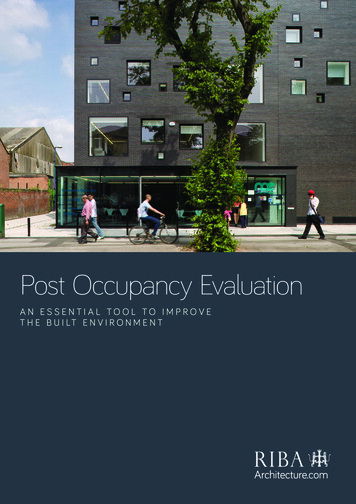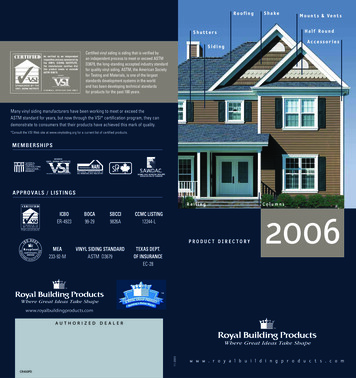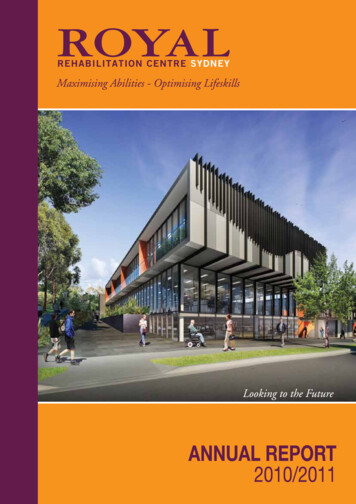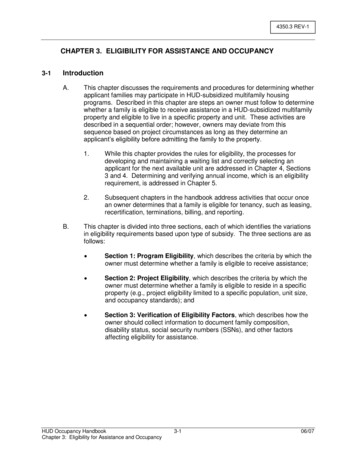
Transcription
Post Occupancy EvaluationAN ESSENTIAL TOOL TO IMPROVET H E B U I LT E N V I R O N M E N T
Foreword3Executive summary5Recommendations6Introduction6Chapter 1 POE helps make buildings greener and healthier8Chapter 2 POE can reveal how a building is used compared toits designers’ intentions10Chapter 3 POE reduces operational costs11Chapter 4 POE allows for continuous improvement12Chapter 5 POE can help reduce delays and overspends on future projects13Chapter 6 POE increases user satisfaction14It’s time to take action15Building sustainably – what’s the real cost?17Appendix18Cover image – Architect: Hawkins\Brown Photography: Tim Crocker
ForewordWe need to improve our built environment. It contributes to, and impacts upon,our world and our lives in so many ways that we must strive for significantimprovements to make it better.From the existential risk of climate emergency upon our planet, to health andwell‑being, the physical environment impacts on human behaviour. The knowledgeof how our buildings perform functionally and environmentally must inform futuredesign and delivery to ensure spaces truly meet the needs of those using them.Governments, society and users want our industry to deliver consistency,quality and sustainability. We need to understand how each completed projectis meeting the defined needs and performance and how improvements can bemade for the future.As Dame Judith Hackett noted in her report on the disaster at Grenfell Tower,nothing less than a culture change is required in the construction industry toaddress issues of quality, safety and sustainability.The Royal Institute of British Architects (RIBA) believe that we would all benefitfrom an approach that made it easier to learn from both successful and moretroubled projects via Post Occupancy Evaluation. To observers from othersectors, this sounds obvious. We need to embrace a culture of accountabilityand continuous improvement.Those that live in and use our buildings, as well as the environment, deserve andurgently need us to make these changes.Professor Alan M JonesRIBA President3
Royal Institute of British Architects Post Occupancy EvaluationArchitect: Hawkins\Brown Photography: Tim Crocker4
Executive summaryPost Occupancy Evaluation (POE) is the process of obtainingfeedback on a building’s performance in use after it has been builtand occupied. POE collects information on building and energy useand user satisfaction.This paper highlights the benefits of POE for new buildingsusing case study examples in the domestic and non-domesticsectors. It discusses the financial costs of POE and providesrecommendations that Government, local authorities and the widerconstruction sector should action to ensure that new buildings areas energy efficient as intended, provide value for money and builtenvironment continuously improves.There are three broad levels of POE: Light touch POE: a simple but meaningful rapid evaluationundertaken post occupancy, before the building contractconcludes. Diagnostic POE: feedback from a light touch POE may highlightthe need for a more detailed review of a building. Detailed (forensic) POE: a comprehensive investigation, byindependent evaluators, to identify and resolve any significantand persistent performance issues.POE provides data to help understand how buildings areperforming compared to their design intention. Without this data,the construction industry will unknowingly continue to make thesame mistakes, wasting time and money.POE also informs building users if their building is energy efficientand reveals if it is being used as intended. Addressing these issuescan help reduce operational costs.Despite these benefits, POE is still not embedded in all projects.Ensuring the widespread adoption of POE will require systemic0.1 -0.25%%Research shows as a proportion of aproject’s cost, undertaking POE addsan additional 0.1% – 0.25%cultural changes in the construction sector. This should be ledthrough a top-down approach from Government who should requirePOE as a condition when public money is spent. The NationalAudit Office should hold the Government to account, and highlightwhether, or not, POE has been undertaken on any project thatreceives public funding.This should be complemented by a bottom-up approach. Builtenvironment professionals should highlight the benefits of POEto clients and include POE as standard when bidding for projects.POE should be taught at university so it is engrained from theoutset of a built environment professionals’ career, and theprofessional institutes should work together to promote POE andshare information on overall findings and building performance.The cost of POE is a very small percentage of overall buildingcosts. Research shows as a proportion of a project’s cost,undertaking POE adds an additional 0.1% – 0.25%.1 In 2019, publicsector construction output was 4 billion on new construction workon schools and colleges.2 POE on this figure, at 0.1% to 0.25% ofupfront costs, would be approximately 4 million to 10.1 million.This cost is tiny compared to the benefits of undertaking POE.When POE is considered from the outset as part of a widerbuilding strategy, the costs can be reduced. The cost of POEincreases when the installed energy metering infrastructure is notat an adequate standard. This makes it difficult to ascertain whereenergy is being used throughout a building; in turn, adding time,and cost, to gathering and understanding this data.As POE becomes standard the lessons learnt can help informnew projects, allowing for continuous improvement within the builtenvironment. As buildings improve, the cost of POE depreciates. 4bnIn 2019, public sector constructionoutput was 4bn on new constructionwork on schools and colleges5
RecommendationsThe RIBA recommends that:Government Endorse and promote that all buildings undertake POE. Require POE as a condition of procurement for building projectsusing public funding. Require POE as a condition of housebuilders receivingHelp to Buy payments. Investigate how the Building Regulations could be amendedto include POE.The National Audit Office (NAO) Publicly state that all new buildings that receive public fundingshould undertake POE to ensure that they are providing goodvalue for money. Highlight in NAO reviews whether, or not, POE has beenundertaken on any project that receives public funding.Built environment sector Built environment professionals should highlight the benefitsof POE to clients and include POE as standard when biddingfor projects. Universities should include teaching detailed or forensic POEsin the curriculum to ensure that all built environment studentsunderstand the benefits and the methodology of POE. Built environment professionals should share data andinformation collected through POE. Professional institutes should work together to promote POEand share information on learnings and building performance.Clients Ensure that POE is included in your contractual obligations withthe project team from the outset. Scrutinise the data collected through POE to ensure buildingsare meeting their design intentions.Local authorities Mandate the use of POE, and data sharing, on large scalehousing schemes by making it a requirement through theplanning system. Mandate the use of POE on all appropriate projects deliveredby locally controlled or owned registered social landlords. Ensure that POE is delivered on local authority contracts whereappropriate.POEEnsure that POE is deliveredon local authority contracts whereappropriate6Royal Institute of British Architects Post Occupancy EvaluationBuilt environment professionalsshould share data and informationcollected through POE
IntroductionIf the construction sector is serious aboutreform and improvement, it needs toembrace POEPost Occupancy Evaluation (POE) is the process of understandinghow well a building meets the needs of clients and buildingoccupants. By accurately measuring factors such as building useand occupancy, energy consumption, water usage, maintenancecosts and user satisfaction, POE highlights if a building is meeting itsdesign intention. This creates a process of continuous improvementin the construction industry.If the construction industry is going to play its part in deliveringthe quality, safety and sustainability improvements that weneed to see in coming years, POE will be an essential tool. Thewidespread adoption of POE will require systemic cultural changesin the sector. To ensure this is as effective as possible, the RIBArecommends both a top-down and bottom-up approach –Government, local authorities, the wider built environment andclients all have a role to play in achieving this.POE makes buildings greener, cheaperand more productiveThere are both qualitative and quantitative reasons to adopt POE.From lower energy bills to reductions in carbon emissions,a culture of continuous improvement can deliver huge returns oninvestment. POE does this in six ways:1. Making buildings greener and healthier2. Revealing how a building is used compared to its designers’intentions3. Reducing operational costs4. Allowing for continuous improvement5. Reducing delays and overspends on future projects6. Increasing user satisfactionMost buildings will outlive their creators – to ensure that they arefit for future generations we need to be confident that we are doingall we can to build the best buildings possible.POE can be part of the solutionThe Royal Institute of British Architects (RIBA) has been promotingthe use of POE since the early 1960s when the first RIBA Plan ofWork was published. Today, POE remains the key tool to measuringthat our buildings meet their design intentions, the needs of theclient and that the built environment continuously improves.By accurately measuring key factorsPOE highlights if a building is meetingits design intentionPOE outputs can inform new projects,new processes, new systems and newdesigns, achieving better buildings7
1POE helps make buildings greener and healthierAddressing energy efficiency in buildings is crucial to reaching netzero. Buildings are responsible for 40% of UK carbon emissions.POE confirms that the designed energy efficiency targets of abuilding have been achieved. If the requirements have not beenmet it highlights what actions need to be taken to meet the desiredtargets. In the current context of a climate emergency, it is vital thatbuildings are meeting their anticipated energy efficiency metrics.To ensure our built environment is sustainable, our buildings mustbe as energy efficient as possible and we must have a tool tomeasure improvement – POE is the solution.In 2019, the Government declared a climate and biodiversityemergency and legislated to reach net-zero by 2050. The RIBAjoined this call to action by declaring a climate emergency andlaunching the RIBA 2030 Climate Challenge. The 2030 Challengecalls on architects to meet net zero (or better) whole life carbon fornew and retrofitted buildings by 2030. The Challenge sets stagedtargets for operational energy, embodied carbon and potablewater usage for 2020, 2025 and 2030 for both domestic andnon‑domestic buildings.Carbon emissions in the built environment are created throughoutthe whole building lifecycle, from strategy, to technical delivery,use and reuse. An especially intensive part of this cycle is heatingbuildings, which in the UK accounts for 19% of carbon emissions.It is important therefore, for the built environment to become moreenergy efficient. The UK has the least energy efficient housingstock in Europe, this contributes to approximately 3,000 deathsdue to the cold3 and 2,000 deaths due to overheating per year.4Even if a building’s design has energyefficiency at its heart, the promisedenergy efficiency standards are notalways metA key issue here is the insufficient data and information on theenergy efficiency of buildings compared to their intended designperformance. This lack of data makes it difficult to understandwhere and how improvements on energy efficiency in a buildingcan be made. Undertaking POE is a key to understanding whethera building’s energy performance is in line with expectations at thedesign stage.8Royal Institute of British Architects Post Occupancy EvaluationPOE is the only way of accuratelymeasuring if a building is as energyefficient as anticipatedThere is significant evidence that buildings tend to over promiseand underperform, particularly in relation to energy efficiency. POEverifies to both the building owner and user that it is as energyefficient as promised.Buildings, of all sizes, are expensive – for example, as an individual,building a home may be one of the most expensive exercises everundertaken; local authorities who are building social housing mustensure every pound spent provides value for money; and newlandmark, multi-storey office blocks cost hundreds of millions ofpounds. The construction industry is one of the few sectors wheresuch a large sum of money is spent and there is no assurance thatthe building performs as intended.“We’d rather spend 10 million on a buildingand hope it might work, than 100,000before to show that it should, and 100,000afterwards to make sure that it did”Paul Morrell, UK Government Chief ConstructionAdvisor (2009 – 2012)In addition, most other industries have a much better cultureof ensuring their product performs and meets customerrequirements. For example, Rolls-Royce, through their TotalCare maintenance package, offer their aerospace customers the choiceto transfer the burden of engine maintenance and associated risksfrom the customer back to Rolls-Royce. TotalCare is charged on afixed cost per flying hour, so Rolls-Royce are only rewarded whenengines perform.5
Case studyCase studyAssessing the performance of 188 homes across the UK,research by Innovate UK, revealed that despite all homesbeing “low energy” and 50 certified Passivhaus, many ofthe homes were losing heat at the windows and doors.The POE used a range of fabric thermal performancetests and infrared thermal imaging to highlight wherethe problems were occurring. The tests exposed thatthere was a need for improved detailing, specificationand workmanship. This highlighted that whilst there isthe intention of producing “low energy” homes this isnot always how the home operates in reality. Withoutundertaking the study, the homeowners would notunderstand how much energy their home uses comparedto the intention. The POE highlighted the issues to berectified, and as a result the energy consumption of thebuildings was reduced.Image Levitt BernsteinImage Tim CrockerHighlighting energy efficiencyperformance gapsProviding evidence thata building is working asintendedArchitecture practice Levitt Bernstein undertook a POEtogether with the client Origin Housing on a housingscheme of 42 homes at Loudoun Road in the LondonBorough of Camden. The project brief had sustainabilityat its core and whilst not Passivhaus certified, the projectteam designed to these principles. Using a highly efficientbuilding envelope including high levels of insultationand airtightness, the development achieved an averagereduction across the site of 54% in CO2 emissionscompared to the relevant Building Regulations. The POErevealed that focusing on high fabric performance duringdesign and construction could reduce the performancegap; and the building performed better than predicted atdesign stage. With the UK Government’s focus on raisingdesign quality along with energy efficiency targets, the datacollected from Loudon Road provides valuable insights intohow this could be achieved.9
2POE can reveal how a building is usedcompared to its designers’ intentionsIf a building is not used and operated as its designers intended, itcan be less energy efficient than anticipated; POE can reveal how abuilding is used and helps rectify misuse.POE can highlight items that needattention or fine tuningThe normal process of defect rectification does not necessarilypick up such issues because it is often focused on what is visible.POE equips the project team with the information they require toincrease energy efficiency and maximise building performanceprior to the conclusion of the building contract.10 Royal Institute of British Architects Post Occupancy EvaluationCase studyUnderstanding howenergy saving productswork in practiceInnovate UK conducted a POE on three low-carbon socialhousing developments in the South-East. The homes usedMechanical Ventilation with Heat Recovery (MVHR) systemto help maintain heating and ventilation levels. MVHRsystems can significantly reduce energy consumption atrelatively low costs. The POE, which included interviewswith occupants, revealed that poor installation andcommissioning of the MVHR system had resulted inworsened performance in fresh air supply, indoor air qualityand high energy consumption. This was made worse bypoor understanding of the system among residents whichhad led to it being misused or disabled. The POEs resultedin recommendations of how to improve commissioningof ventilation systems, as well as highlighting the need forbetter training for residents along with more user-friendlyand intuitive controls.
3POE reduces operational costsWhilst the increased energy efficiency of a building is a key benefitof undertaking POE, it is not the only benefit.Case studyReducing operational costsUsing a building efficiently, for example,reducing the required heating, coolingand improving space management, canresult in lower costsAHMM undertook a retrofit on their own offices inClerkenwell, with the aim to provide energy efficient anduplifting open-plan workspace, through the maximisation ofnatural light and ventilation, improved thermal performanceand the use of renewable technologies. The POE involveda comparison of AHMM’s previous offices, located in thesame building prior to refurbishment, with the performanceof their new studio space. Investment and operational costswere also reviewed alongside other human metrics suchas absentee and staff turnover rates. The POE revealedthat operating costs reduced significantly as a result of therefurbishment, seeing a 69% reduction in total energy useper desk space compared to the previous office.Analysis shows that for a 30-year old office building, the relationshipbetween construction, maintenance and operating costs is 1:5:200,respectively.6 The operational costs of a building have a substantialimpact on the total cost of the building’s life cycle.POE is a tool to help keep costs lowImage iStockphotoUnderstanding how a building is operating and if it is meeting itsenergy efficiency requirements is key to ensuring operational costsremain as low as possible. Without POE a building user does notknow where or how they could be saving money.11
4POE allows for continuous improvement,making future projects deliver better valuePOEs provide information on how a buildings design could beimproved, which allows architects to modify and alter spaces thatare not functioning as expected or in accordance with actual needs.In addition, the operational data gathered from POE can informthe design and construction of future projects. Reducing the need foradjustments once a building is occupied resulting in lower costs.Case studyThe value of a building goes further thanjust financial costThere is a need to focus on the value outcomes a project can deliver,not just the cost of construction. Continuous improvement canhelp reduce the cost of future projects and can help improve othervalue outcomes. The RIBA continues to support the ConstructionLeadership Council’s drive to change procurement decision-makingthrough the Procuring for Value approach. POE is the key tool toassess whether a project has delivered its proposed value, both infinancial and social outcomes.Case studyContinuous improvement ofschools in the West MidlandsA ten-year programme of POE research undertakenby Architype on six successively built schools in theWolverhampton area has led to improvements in the design,construction, and management of each successive schoolbuilding. Wilkinson Primary uses almost 70% less energyto heat spaces and provide hot water compared to thefirst school built in the area. Refined building designs andconstruction processes have significantly reduced runningcosts and made the building far easier to run from anoperational perspective. The improvements have benefittedschool staff and pupils, who have rated the building asproviding high levels of satisfaction and comfort at all timesof the year.12Royal Institute of British Architects Post Occupancy EvaluationImage URBEDPOE provides invaluable feedback and lessons learnt that allinvolved can take forward into their organisations and to theirnext projects. This ‘closes the loop’ that feeds back to thebeginning of a project; by using POE outputs to inform new projects,new processes, new systems and new designs, you achieve betterbuildings. Without objective review, analysis and comparison betweenpredicted and actual building performance, future improvementsin building design, construction and operability may not occur.Providing insights on howto improve a building’sperformanceUrbanism, Environment and Design (URBED) are a researchconsultancy who have been developing tools and processesto assess master-planning projects against a sustainableinvestment policy. Understanding how developments workin-use is a crucial component of this work. One POE studyrevealed the impact of the use of halogen lighting and itscontribution to overheating, leading to the installation of moreefficient LED lamps. Common lessons have been learntand these have influenced the design of future projects. Forexample, a much greater emphasis is now placed on a ‘fabricfirst’ approach to achieve energy targets and carbon emissionsreductions. The development of learning through POE is fedinto future projects to refine processes, designs and hand-overprocedures which are of mutual benefit to clients, designersand building occupants.
5POE can help reduce delays andoverspends in construction projectsThis is not only important when projects utilise MMC, but someprojects, for example, schools, supermarkets and hospitals oftenuse standardised designs. Learning from previous projects isimperative to ensure buildings continuously improve.The information collected and the feedback loop is especiallyinvaluable as the use of modern methods of construction (MMC)increases. MMC, a collective term for a wide range of nontraditional building systems, which includes modular construction,panelised systems, and sub-assemblies and components7, hasbeen acknowledged by Government as key to unlocking a homebuilding revolution in the UK8. MMC brings a greater level ofstandardisation, which if executed poorly can result in hundredsof buildings experiencing the same problem. POE is a tool thatcan help identify systemic issues that may occur in a project thatutilises MMC and rectify these issues for future projects. This savestime and money in the long run by constructing buildings that donot require fixing in the future.Whether an architect has previous experience of POE, and thelessons learnt from this process, may be asked by potential clients.These questions can carry a score during the bid process and if afirm is unable to show experience of conducting POE this couldresult in reduced chances of winning a project. POE is way ofsignifying that a building is working as intended and demonstratesto potential clients that an architect can design a building to meetthe desired performance.Image URBEDConducting POE has the potential to de-risk projects over the longterm as the feedback on the design and construction process andcontinuous improvements ensures that lessons are learnt fromprevious experience.13
6POE increases user satisfactionPOE provides actionable insight into whether the building meetsthe desired requirements for the people who inhabit it. Undertakinga POE can, therefore, determine whether the initial brief wasachieved and can rectify any weaknesses. This ensures that theuser’s intentions are met and that they are satisfied with the project.This can also strengthen the relationship with client as they canprovide feedback on operational improvements.Case study14Image Jack HobhouseArchitect: Hawkins\Brown Photography: Tim CrockerCase studyUnderstanding needsincreases satisfactionHelping people to understandtheir homesA series of POEs were carried out on the New Art Exchange, acultural centre in Nottingham to understand how the buildingwas performing from the perspective of its users. The POEshelped to identify actions needed to resolve issues raised –such as the need for more user-friendly instruction manualsand a longer handover period to resolve building servicesand management issues. The gallery staff had not beeninformed that heavy duty plasterboards had been installedspecifically to accommodate heavy exhibits – through thePOE process the full capacity of the gallery can now be used.Issues with overheating in summer were also resolved througheducating staff on the best use of windows to ensure sufficientventilation, in particular for night-time cooling. The resultingchanges have led to better space management and increaseduser satisfaction.Between 2018 and 2020, a POE was undertaken by thearchitecture practice, Architype, in collaboration with acouncil, large contractor and the wider design team. ThePOE and environmental monitoring evaluated the largestPassivhaus residential schemes in the UK. The developmentwas phased, to allow lessons learnt from earlier phases tobe utilised in latter stages of the project. This was particularlybeneficial for ensuring user satisfaction. For example, inthe first phase of the development there were commentson the lack of visible radiators. The perception of wantingto see radiators was noted, and for the second phase theheating demand was split between more radiators to give theperception of a more traditional heating system.Royal Institute of British Architects Post Occupancy Evaluation
It’s time to take actionYou can’t improve qualityif you don’t monitor itPOE is still not common practice in the built environment. Only 19%of practices in the UK offer clients a POE service.9 However, RIBAresearch shows that only 3% of practices always measure actual oranticipated operational energy through POE, and 50% never do.10The RIBA believes that the Government has a vital role to play inensuring that undertaking POE becomes the norm. In the UK, theGovernment accounts for 25% of the construction sector.11 Putit simply, by not pushing for reform, the Government is failing tomake the best use of its money.An effective POE strategy will bringhuge benefits to GovernmentGovernment should require POE wherever public moneyis being spent.A few Government departments are embracing POEs, mainlydriven by the Government Soft Landings policy – a mechanismfor ensuring a smooth transition from briefing, through design andconstruction phases to the operational phase of a built asset.However, the implementation has not been widespread. TheMinistry of Housing, Communities and Local Government, forexample, does not require POE on housing projects that receivepublic funding. This must change and Government should requireany building which receives public funding to conduct POE. Fromhousebuilders who receive Help to Buy support to commercial andindustrial developers seeking public sector clients, the Governmentcan and should demand more from those it supports.To promote the use of POE in privately funded projects, the RIBArecommends that the Government investigate how the BuildingRegulations could be amended to include POE.The National Audit Office must rethinkhow it scrutinises construction projectsThe National Audit Office (NAO) scrutinises public spending onbehalf of Parliament and undertakes value for money studiesand investigations. These recommendations and reports helpGovernment use public money wisely and improve lives. It istherefore disappointing that the NAO have so far failed to pushPOE more aggressively.The NAO has made a number of recommendations that recognisethe benefits of POE and has recommended it in the past. In 2017,‘Capital funding for schools’, recommended that the Departmentfor Education should evaluate the quality of the buildings to assesscost effectiveness, identify good practice, and analyse the data tounderstand how buildings can be improved.12 The 2007 report‘Building for the future: Sustainable construction and refurbishmenton the government estate’ highlighted the lack of POE undertakenin the Government estate. The report recommended thatimproving the sustainability of these buildings through the use ofPOE to assess whether the projects had delivered the desired levelof performance.13 ‘Getting Value for Money from ConstructionProjects through Design: How Auditors Can Help’, published in2004, also highlights the benefits of POE.14However, these references are few and far between given thebroad scope and political weight of the NAO’s work. To drive thePOE agenda forward, the NAO should publicly state that all newbuildings that receive public funding should undertake POE toensure that they are providing good value for money.The NAO should also highlight in their reviews of Governmentspending whether, or not, POE has been undertaken on anyproject that receives public funding. The data collected throughPOE should be scrutinised by the NAO to ensure publicly fundedbuildings are meeting the required design intentions for energyefficiency and user satisfaction.RIBA recommendations for Government:RIBA recommendations for the NAO: Endorse and promote that all buildings undertake POE. Publicly state that all new buildings that receive publicfunding should undertake POE to ensure that they areproviding good value for money.
Light touch POE: a simple but meaningful rapid evaluation undertaken post occupancy, before the building contract concludes. Diagnostic POE: feedback from a light touch POE may highlight the need for a more detailed review of a building. D










